Chinese calligraphy
| Chinese calligraphy | |||||||||||||||||||||||
 | |||||||||||||||||||||||
| Chinese name | |||||||||||||||||||||||
|---|---|---|---|---|---|---|---|---|---|---|---|---|---|---|---|---|---|---|---|---|---|---|---|
| Traditional Chinese | 書法 | ||||||||||||||||||||||
| Simplified Chinese | 书法 | ||||||||||||||||||||||
| |||||||||||||||||||||||
| Vietnamese name | |||||||||||||||||||||||
| Vietnamese alphabet | Thư pháp | ||||||||||||||||||||||
| Chữ Hán | 書法 | ||||||||||||||||||||||
| Korean name | |||||||||||||||||||||||
| Hanja | 書藝 | ||||||||||||||||||||||
| |||||||||||||||||||||||
| Japanese name | |||||||||||||||||||||||
| Kanji | 書道 | ||||||||||||||||||||||
| Hiragana |
しょどう (modern) しよだう (historical) | ||||||||||||||||||||||
| |||||||||||||||||||||||
Chinese calligraphy is a form of calligraphy widely practiced in China and revered in the Chinese cultural sphere, which often includes Japan, Korea, Taiwan and Vietnam. The calligraphic tradition of East Asia originated and developed from China. There is a general standardization of the various styles of calligraphy in this tradition. Chinese calligraphy and ink and wash painting are closely related, since they are accomplished using similar tools and techniques. Chinese painting and calligraphy distinguish themselves from other cultural arts because they emphasize motion and are charged with dynamic life. According to Stanley-Baker, "Calligraphy is sheer life experienced through energy in motion that is registered as traces on silk or paper, with time and rhythm in shifting space its main ingredients."[1] Calligraphy has also led to the development of many forms of art in China, including seal carving, ornate paperweights, and inkstones.
Definition and classification
- Names
The local name for calligraphy is Shūfǎ 書法 in China, literally "the way/method/law of writing";[2] Shodō 書道 in Japan, literally "the way/principle of writing"; and Seoye (서예) 書藝 in Korea, literally "the skill/criterion[3] of writing". The calligraphy of Chinese characters is an important and appreciated aspect of Chinese culture. Chinese calligraphy is normally regarded as one of the "arts" (Chinese 藝術 pinyin: yìshù) in the countries where it is practiced. It is also worth to note that Chinese calligraphy focuses not only on methods of writing but also on cultivating one's character (人品).[4]
- As a practice
As a discipline calligraphy is, at the basic level, a pursuit -書法 pinyin: shūfǎ, "the rules of writing Han characters"[5]- focused on writing well. Students aim to obtain the writing characteristics of exemplary pieces of writing. Elementary school students practice calligraphy in this way, as do elders practicing temporary calligraphy, without aspiring to artistic creation.
- As an art
Calligraphy is also considered an art - 藝術/艺术 pinyin: yìshù, a relatively recent word meaning "art",[6] where works are appreciated more or only for their aesthetic qualities.
Evolution Style
There are five main categories of Chinese traditional calligraphy: Hsin (aka Xing), Tsao (aka Cao), Zuan (aka Zhuan), Li, and Kai. Hsin is a developing style between Tsao and Kai. Tsao calligraphy was started during the Han Dynasty. Zuan was started in China in 221 BC. Li is a transforming style of Zuan. Nowadays Kai is the most commonly used style of Chinese calligraphy, and it is also regarded as the official style.
Evolution and styles
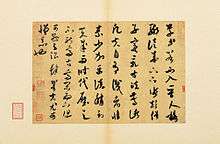
- Ancient China
Chinese characters can be retraced to 4000 BC signs (Lu & Aiken 2004).
In 2003, at the site of Xiaoshuangqiao (小双桥), about 20 km southeast of the ancient Zhengzhou Shang City, ceramic inscriptions dating to 1435–1412 BC have been found by archaeologists. These writings are made in cinnabar paint. Thus, the dates of writing in China have been confirmed for the Middle Shang period.[7]
The ceramic ritual vessel vats that bear these cinnabar inscriptions were all unearthed within the palace area of this site. They were unearthed mostly in the sacrificial pits holding cow skulls and cow horns, but also in other architectural areas. The inscriptions are written on the exterior and interior of the rim, and the exterior of the belly of the large type of vats. The characters are mostly written singly; character compounds or sentences are rarely seen.[7]
The contemporary Chinese characters set principles were clearly visible in ancient China's Jiǎgǔwén characters carved on ox scapulas and tortoise plastrons around 14th - 11th century BCE (Lu & Aiken 2004). Brush-written examples decay over time and have not survived. During the divination ceremony, after the cracks were made, characters were written with a brush on the shell or bone to be later carved.(Keightley, 1978). With the development of Jīnwén (Bronzeware script) and Dàzhuàn (Large Seal Script) "cursive" signs continued. Moreover, each archaic kingdom of current China had its own set of characters.
- Imperial China
In Imperial China, the graphs on old steles — some dating from 200 BC, and in Xiaozhuan style — are still accessible.
In about 220 BC, the emperor Qin Shi Huang, the first to conquer the entire Chinese basin, imposed several reforms, among them Li Si's character unification, which created a set of 3300 standardized Xiǎozhuàn characters.[8] Despite the fact that the main writing implement of the time was already the brush, little paper survives from this period, and the main examples of this style are on steles.
The Lìshū style (clerical script) which is more regularized, and in some ways similar to modern text, were also authorised under Qin Shi Huang.[9]
Kǎishū style (traditional regular script) — still in use today — and attributed to Wang Xizhi (王羲之, 303-361) and his followers, is even more regularized.[9] Its spread was encouraged by Emperor Mingzong of Later Tang (926-933), who ordered the printing of the classics using new wooden blocks in Kaishu. Printing technologies here allowed shapes to stabilize. The Kaishu shape of characters 1000 years ago was mostly similar to that at the end of Imperial China.[9] But small changes have been made, for example in the shape of 广 which is not absolutely the same in the Kangxi Dictionary of 1716 as in modern books. The Kangxi and current shapes have tiny differences, while stroke order is still the same, according to old style.[10]
Styles which did not survive include Bāfēnshū, a mix of 80% Xiaozhuan style and 20% Lishu.[9] Some Variant Chinese characters were unorthodox or locally used for centuries. They were generally understood but always rejected in official texts. Some of these unorthodox variants, in addition to some newly created characters, were incorporated in the Simplified Chinese character set.
- Cursive styles and hand-written styles
Cursive styles such as Xíngshū (semi-cursive or running script) and Cǎoshū (cursive or sloppy script) are less constrained and faster, where more movements made by the writing implement are visible. These styles' stroke orders vary more, sometimes creating radically different forms. They are descended from Clerical script, in the same time as Regular script (Han Dynasty), but Xíngshū and Cǎoshū were used for personal notes only, and were never used as standard. Caoshu style was highly appreciated during the reign of Emperor Wu of Han (140 BC−87BC).[9]
- Printed and computer styles
Examples of modern printed styles are Song from the Song Dynasty's printing press, and sans-serif. These are not considered traditional styles, and are normally not written.
-

Small seal script
-

Regular script (traditional)
-

Regular script (simplified)
Materials and tools
The ink brush, ink, paper, and inkstone are essential implements of Chinese calligraphy. They are known together as the Four Treasures of the Study. In addition to these four tools, a water-dropper, desk pads and paperweights are also used by calligraphers.
%2C_Gurgaon%2C_near_Delhi.jpg)
Brush Pen
The brush pen is a traditional writing instrument in Chinese calligraphy. The body of the brush pen can be made from either bamboo, or other materials such as red sandalwood, glass, ivory, silver, even gold. The head of the brush pen can be made from the animal hair, including the weasel, rabbit, deer, goat, pig, tiger, wolf, etc. There is also a tradition in both China and Japan of making a brush using the hair of a newborn, as a once-in-a-lifetime souvenir for the child. This practice is associated with the legend of an ancient Chinese scholar who scored first in the imperial examinations by using such a personalized brush. Calligraphy brushes are widely considered an extension of the calligrapher's arm.
Today, calligraphy may also be done using a pen.
Paper
Paper is frequently sold together with a paperweight and desk pad.
- Paper

Some people insist that Chinese calligraphy should use special papers, such as Xuan paper, Maobian paper, Lianshi paper etc. Any modern papers can be used for brush writing. Because of the long-term uses, Xuan paper became well-known by most of Chinese calligraphers.
In China, Xuanzhi (宣紙), traditionally made in Anhui province, is the preferred type of paper. It is made from the Tatar wingceltis (Pteroceltis tatarianovii), as well as other materials including rice, the paper mulberry (Broussonetia papyrifera), bamboo, hemp, etc. In Japan, washi is made from the kozo (paper mulberry), ganpi (Wikstroemia sikokiana), and mitsumata (Edgeworthia papyrifera), as well as other materials such as bamboo, rice, and wheat.
- Paperweights
Paperweights are used to hold down paper. A paperweight is often placed at the top of all but the largest pages to prevent slipping; for smaller pieces the left hand is also placed at the bottom of the page for support. Paperweights come in several types: some are oblong wooden blocks carved with calligraphic or pictorial designs; others are essentially small sculptures of people or animals. Like ink stones, paperweights are collectible works of art on their own right.
- Desk pads
The desk pad (Chinese T: 畫氈, S: 画毡, Pinyin: huàzhān; Japanese: 下敷 shitajiki) is a pad made of felt. Some are printed with grids on both sides, so that when it is placed under the translucent paper, it can be used as a guide to ensure correct placement and size of characters. However, these printed pads are used only by students. Both desk pads and the printed grids come in a variety of sizes.
Ink and inkstick
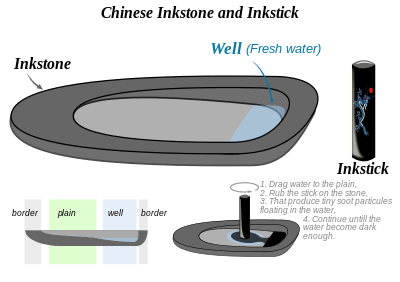

The ink is made from lampblack (soot) and binders, and comes in inksticks which must be rubbed with water on an inkstone until the right consistency is achieved. Much cheaper, pre-mixed bottled inks are now available, but these are used primarily for practice as stick inks are considered higher quality and chemical inks are more prone to bleeding over time, making them less suitable for use in hanging scrolls. Learning to rub the ink is an essential part of calligraphy study. Traditionally, Chinese calligraphy is written only in black ink, but modern calligraphers sometimes use other colors. Calligraphy teachers use a bright orange or red ink with which they write practice characters on which students trace, or to correct students' work.
Inkstone
Made from stone, ceramic, or clay from the banks of the Yellow River, inkstone is used to grind the solid inkstick into liquid ink and to contain the ink once it is liquid. Chinese inkstones are highly prized as art objects and an extensive bibliography is dedicated to their history and appreciation, especially in China.
Seal and seal paste

Calligraphic works are usually completed by the calligrapher putting his or her seal at the very end, in red ink. The seal serves the function of a signature.
Technique: principles

The shape, size, stretch and type of hair in the brush, the color and density of the ink, as well as the absorptive speed and surface texture of the paper are the main physical parameters influencing the final result. The calligrapher also influences the result by the quantity of ink/water he lets the brush take up, then by the pressure, inclination, and direction he gives to the brush, producing thinner or bolder strokes, and smooth or toothed borders. Eventually, the speed, acceleration and deceleration of the writer's moves, turns, and crochets, and the stroke order give the "spirit" to the characters by influencing greatly their final shape.
Study

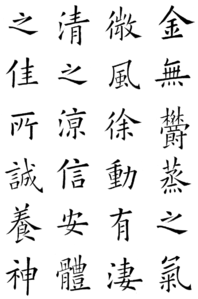
Traditionally, the bulk of the study of calligraphy is composed of copying strictly exemplary works from the apprentice's master or from reputed calligraphers, thus learning them by rote. The master showing the 'right way' to draw items, which the apprentice have to copy strictly, continuously, until the move becomes instinctive and the copy perfect. Deviation from the model is seen as a failure.[1] Competency in a particular style often requires many years of practice. Correct strokes, stroke order, character structure, balance, and rhythm are essential in calligraphy. A student would also develop their skills in traditional Chinese arts, as familiarity and ability in the arts contributes to their calligraphy.
Since the development of regular script, nearly all calligraphers have started their study by imitating exemplary models of regular script. A beginning student may practice writing the character 永 (Chinese: yǒng, eternal) for its abundance of different kinds of strokes and difficulty in construction. The Eight Principles of Yong refers to the eight different strokes in the character, which some argue summarizes the different strokes in regular script.
How the brush is held depends on the calligrapher and which calligraphic genre is practiced. Commonly, the brush is held vertically straight gripped between the thumb and middle finger. The index finger lightly touches the upper part of the shaft of the brush (stabilizing it) while the ring and little fingers tuck under the bottom of the shaft, leaving a space inside the palm. Alternatively, the brush is held in the right hand between the thumb and the index finger, very much like a Western pen. A calligrapher may change his or her grip depending on the style and script. For example, a calligrapher may grip higher for cursive and lower for regular script.
In Japan, smaller pieces of Japanese calligraphy are traditionally written while in seiza. In modern times, however, writers frequently practice calligraphy seated on a chair at a table. Larger pieces may be written while standing; in this case the paper is usually placed directly on the floor, but some calligraphers use an easel.
Basic calligraphy instruction is part of the regular school curriculum in both China and Japan and specialized programs of study exist at the higher education level in China, Korea, and Japan. In contemporary times, debate emerged on the limits of this copyist tradition within the modern art scenes, where innovation is the rule, while changing lifestyles, tools, and colors are also influencing new waves of masters.[1][13]
Chinese calligraphy is being promoted in Chinese schools to counter Character amnesia brought on by technology usage.[14]
Evaluation and appreciation
What is considered good calligraphy often varies depending on individual preferences. However, there are established traditional rules which cannot be violated. Violation of these rules will render a calligraphic work unable to be considered good calligraphy. Those who repeatedly violate these rules are not considered legitimate calligraphers.[6] Among these rules are:
- The characters must be written correctly.[6] A correctly written character is composed in a way that is accepted as correct by legitimate calligraphers. Calligraphic works often use variant Chinese characters, which are deemed correct or incorrect case-by-case, but in general, more popular variants are more likely to be correct. Correct characters are written in the traditional stroke order and not a modern standard (See Stroke Order per Polity).
- The characters must be legible.[6] As calligraphy is the method of writing well, a calligraphic work must be recognizable as script, and furthermore be easily legible to those familiar with the script style, although it may be illegible to those unfamiliar with the script style. For example, many people cannot read cursive, but a calligraphic work in cursive can still be considered good if those familiar with cursive can read it.
- The characters must be concise.[6] This is in contrast to Western calligraphy where flourishes are acceptable and often desirable. Good Chinese calligraphy must be unadorned script. It must also be in black ink unless there is a reason to write in other ink.
- The characters must fit their context.[6] All reputable calligraphers in China were well educated and well read. In addition to calligraphy, they were skilled in other areas, most likely painting, poetry, music, opera, martial arts, and Go. Therefore, their abundant education contributed to their calligraphy. A calligrapher practicing another calligrapher's characters would always know what the text means, when it was created, and in what circumstances. When they write, their characters' shape and weight agrees with the rhythm of the phrases, especially in less constrained styles such as semi-cursive and cursive. One who does not know the meaning of the characters they write, but varies their shape and weight on a whim, does not produce good calligraphy.
- The characters must be aesthetically pleasing.[6] Generally, characters that are written correctly, legibly, concisely, and in the correct context are also aesthetically pleasing to some degree. Characters that violate the above rules are often less aesthetically pleasing.
Influences
Japanese and Korean calligraphies
Japanese and Korean people developed specific sensibilities and styles of calligraphies, as well as applying to specific scripts. Japanese calligraphy extends beyond Han characters to also include local scripts such as hiragana and katakana.
In the case of Korean calligraphy, the Hangeul and the existence of the circle required the creation of a new technique.[15]
The existence of temporary calligraphy is also to be noted. This is the practice of water-only calligraphy on the floor which dries out within minutes. This practice is especially appreciated by the new generation of retired Chinese in public parks of China.
Other arts
Calligraphy has influenced ink and wash painting, which is accomplished using similar tools and techniques. Calligraphy has influenced most major art styles in East Asia, including Ink and wash painting, a style of Chinese, Korean, Japanese painting, and Vietnamese painting based entirely on calligraphy.
Notable calligraphers
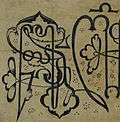 |
| Calligraphy |
|---|
- Wei Shuo 衛鑠 (272–349)
- Wang Xizhi 王羲之 (303–361)
- Wang Xianzhi 王獻之 (344–386)
- Wang Xun 王珣 (349–400)
- Ouyang Xun 歐陽詢 (557–641)
- Yu Shinan 虞世南 (558–638)
- Chu Suiliang 褚遂良 (597–658)
- Emperor Taizong of Tang 唐太宗 李世民 (599–649)
- Zhang Xu 張旭 (658–747)
- Yan Zhenqing 顏真卿 (709–785)
- Huaisu 懷素 (737–799)
- Liu Gongquan 柳公權 (778–865)
- Cai Xiang 蔡襄 (1012–1067)
- Su Shi 蘇軾 (1037–1101)
- Huang Tingjian 黄庭堅 (1045–1105)
- Mi Fu 米黻 (1051–1107)
- Emperor Huizong of Song 宋徽宗 趙佶 (1082–1135)
- Emperor Gaozong of Song 宋高宗 趙構 (1107–1187)
- Zhao Mengfu 趙孟頫 (1254–1322)
- Ni Zan 倪瓚 (1301–1374)
- Tang Yin 唐寅 (1470–1524)
- Wen Zhengming 文徵明 (1470–1559)
- Dong Qichang 董其昌 (1555–1636)
- Huang Ruheng 黃汝亨 (1558–1626)
- Wang Duo 王鐸 (1592–1652)
- Zheng Xie 鄭燮 (1693–1765)
Gallery
-

A copy of Wang Xizhi's Lantingji Xu, the most famous Chinese calligraphic work.
-
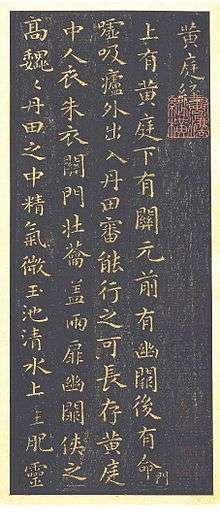
Part of a stone rubbing of 黄庭经 by Wang Xizhi
-

A copy of 上虞帖 by Wang Xizhi
-
A Tang Dynasty copy of 新婦地黃湯帖 by Wang Xianzhi
-

Part of a stone rubbing of 九成宮醴泉銘 by Ouyang Xun
-

Part of a stone rubbing of 雁塔聖教序 by Chu Suiliang
-

Part of a stone rubbing of 顏勤禮碑 by Yan Zhenqing
-

Cry for noble Saichō by Emperor Saga
-

A work of semi-cursive and cursive by Mi Fu
-
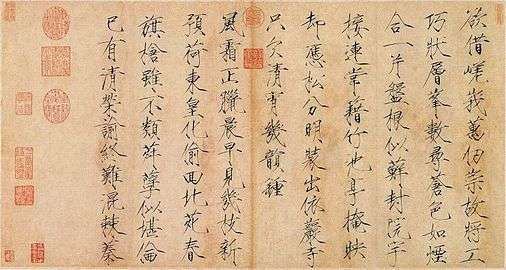
A work by Emperor Huizong of Song
-

Buiseonrando by Kim Jeonghui

See also
- Calligraphy
- Chinese art
- Chinese calligraphy
- Chinese character
- East Asian script styles
- Eight Principles of Yong
- Ink and wash painting
- Japanese art
- Korean art
- Songti
- Stroke order
- Three perfections - integration of calligraphy, poetry and painting
- Wonton font
- Vietnamese art
References
- Internal
- 1 2 3 (Stanley-Baker 2010a)
- ↑ 書 being here used as in 楷书/楷書, etc, and meaning "writing style".
- ↑ Wang Li; et al. (2000). 王力古漢語字典. Beijing: 中華書局. p. 1118. ISBN 7101012191.
- ↑ "Shodo and Calligraphy". Vincent's Calligraphy. Retrieved 2016-05-28.
- ↑ Shu Xincheng 舒新城, ed. Cihai (辭海 "Sea of Words"). 3 vols. Shanghai: Zhonghua. 1936.
- 1 2 3 4 5 6 7 田蘊章《每日一題每日一字》 - Internet video series on Chinese calligraphy
- 1 2 Song Guoding (2004), The Cinnabar Inscriptions Discovered at the Xiaoshuangqiao Site, Zhengzhou. Chinese Archaeology. Volume 4, Issue 1, Pages 98–102
- ↑ Fazzioli, Edoardo (1987) [1987]. Chinese calligraphy : from pictograph to ideogram : the history of 214 essential Chinese/Japanese characters. calligraphy by Rebecca Hon Ko. New York: Abbeville Press. p. 13. ISBN 978-0-89659-774-7.
And so the first Chinese dictionary was born, the Sān Chāng, containing 3,300 characters
- 1 2 3 4 5 Blakney, p6 : R. B. Blakney (2007). A Course in the Analysis of Chinese Characters. Lulu.com. p. 148. ISBN 978-1-897367-11-7.
- ↑ 康熙字典 Kangxi Zidian, 1716. Scanned version available at www.kangxizidian.com. See for example the radicals 卩, 厂 or 广, p.41. The 2007 common shape for those characters does not clearly show the stroke order, but old versions, visible on the Kangxi Zidian p.41 clearly allow the stroke order to be determined.
- ↑ "Chinese - Brushwasher in the Form of a Leaf". The Walters Art Museum.
- ↑ Li, Wendan (2009). Chinese writing and calligraphy. Honolulu: University of Hawaiʻi Press. pp. 14–15. ISBN 978-0-8248-3364-0.
- ↑ (Stanley-Baker 2010b, pp. 9–10)
- ↑ "New calligraphy classes for China's internet generation". BBC NEWS ASIA-PACIFIC. 27 August 2011. Retrieved August 29, 2011.
- ↑ Daikynguyen.com
- Books
- Daniels O, Dictionary of Japanese (Sōsho) Writing Forms, Lunde Humphries, 1944 (reprinted 1947)
- Deng Sanmu 鄧散木, Shufa Xuexi Bidu 書法學習必讀. Hong Kong Taiping Book Department Publishing 香港太平書局出版: Hong Kong, 1978.
- Qiu Xigui, Chinese Writing, Early China Special Monograph Series No. 4. Berkeley: The Society for the Study of Early China and the Institute of East Asian Studies, University of California, Berkeley, 2000. ISBN 1-55729-071-7.
- Ouyang, Zhongshi & Fong, Wen C., Eds, Chinese Calligraphy, Yale University Press, New Haven, 2008. ISBN 9780300121070
- Burckhardt, O. “The Rhythm of the Brush” Quadrant, Vol 53, No 6, (June 2009) pp. 124–126. A review-essay that explores the motion of the brush as the hallmark of Chinese calligraphy.
- Emmanuelle Lesbre, Jianlong Liu: La Peinture Chinoise. Hazan, Paris, 2005, ISBN 978-2-850-25922-7.
- Stanley-Baker, Joan (May 2010a), Ink Painting Today (PDF), 10 (8), Centered on Taipei, pp. 8–11
- Stanley-Baker, Joan (June 2010b), Ink Painting Today (PDF), 10 (9), Centered on Taipei, pp. 18–21
- Lu, W; Aiken, M (2004), "Origins and evolution of Chinese writing systems and preliminary counting relationships", Accounting History, 9 (3), pp. 25–51
- Liu , Shi-yee (2007). Straddling East and West: Lin Yutang, a modern literatus: the Lin Yutang family collection of Chinese painting and calligraphy. New York: The Metropolitan Museum of Art. ISBN 9781588392701.
External links
- Chinese Calligraphy - Dao of Calligraphy in English & Mandarin Chinese
- Chinese Calligraphy at China Online Museum
- Chinese calligraphy
- Styles of Chinese calligraphy
- Models of Chinese calligraphy - Generator of Chinese calligraphy model
- History of Chinese Calligraphy
- History of Calligraphy in Vietnam
- Basic Calligraphy Styles From Taoism contains introductory comparisons of different calligraphy styles of basic characters.
- The History of Chinese Calligraphy at BeyondCalligraphy.com
- Introduction of Chinese Ground Calligraphy or Dishu - mildchina
- 名家书法 (Masters of Calligraphy). Enter a character, click, and see range of variations for that character by different calligraphic masters.





